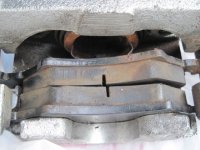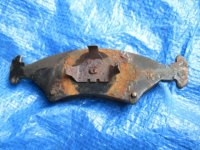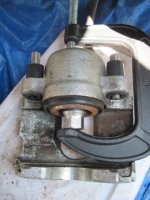You are using an out of date browser. It may not display this or other websites correctly.
You should upgrade or use an alternative browser.
You should upgrade or use an alternative browser.
Bearing Buddies / Bearings Redux
- Thread starter Pat Anderson
- Start date
Pat Anderson
New member
- Joined
- Nov 2, 2003
- Messages
- 8,562
- Reaction score
- 0
- C Dory Year
- 2005
- C Dory Model
- 25 Cruiser
- Vessel Name
- Daydream
jkidd":2xte2h7y said:Pat there are a lot of videos up on YouTube that you can watch to get an idea. Etrailer.com has a lot also. Looks like your having fun anyway.
Jodi, thanks, i have looked at some of those, and none show the same kind of disk brakes I have. Even the Kodiak brake installation video shows a completely different configuration. I will call the place that installed the brakes in 2014 and see if I can find out EXACTLY what brand and type of brakes these are. Without knowing that, it is hard to zero in on any useful information!
Pat Anderson
New member
- Joined
- Nov 2, 2003
- Messages
- 8,562
- Reaction score
- 0
- C Dory Year
- 2005
- C Dory Model
- 25 Cruiser
- Vessel Name
- Daydream
BrentB":2m43gvih said:Pat
Here is Timken pdf showing various bearings issues
Good Luck
Brent, as far as I know, I am not having bearing issues any longer, but rather brake issues, specifically, when I put the brakes back on the newly repacked and installed hub, which turned freely before I put the brakes back on, the wheel no longer turns freely. Hence the deduction by many that the brakes are binding and what I now need to do is pull the inner pad and compress the piston. Where I am right now is that I cannot get the inner pad out of the caliper (it appears to me) without splitting the caliper back into its two component parts.
It occurred to me in the middle of the night that I still have the part of the caliper with the inner pad dangling from a wire from the frame, and first thing I intend to do today is to study it closely and see what I can learn about the inner pad.
Pat Anderson
New member
- Joined
- Nov 2, 2003
- Messages
- 8,562
- Reaction score
- 0
- C Dory Year
- 2005
- C Dory Model
- 25 Cruiser
- Vessel Name
- Daydream
This picture clearly illustrates the current predicament I think. The inner pad is popped out of where it was seated. You can see the clips or springs under fixed part of the caliper. The inner pad cannot be removed because the clips or springs do not clear the fixed part above them and the outer pad blocks tilting or otherwise moving the inner pad to remove it.


Pat Anderson
New member
- Joined
- Nov 2, 2003
- Messages
- 8,562
- Reaction score
- 0
- C Dory Year
- 2005
- C Dory Model
- 25 Cruiser
- Vessel Name
- Daydream
After studying the picture just above and pondering it, I was able to remove the inner pad. I used needle nose pliers and a big screw driver to lever the right hand clip or spring to the right to clear the part above it, and then successively did the same with the other two. Then I was able to remove the inner pad, and I also pulled the outer pad for these pictures.



What I am seeing is a VERY rusty cylinder and no piston? What would you do with this? I could put the caliper back on without the pads and drive to my trailer shop with no brakes on one wheel (assuming I can get the other caliper back on this side so it is not binding) or if I can't, I could pull the pads from the other caliper and drive with no brakes on one side. Does it look to folks like the only solution here is to replace the brakes entirely? I hope not but it kind of looks that way to me.



What I am seeing is a VERY rusty cylinder and no piston? What would you do with this? I could put the caliper back on without the pads and drive to my trailer shop with no brakes on one wheel (assuming I can get the other caliper back on this side so it is not binding) or if I can't, I could pull the pads from the other caliper and drive with no brakes on one side. Does it look to folks like the only solution here is to replace the brakes entirely? I hope not but it kind of looks that way to me.
The cylinder is the piston and looks fine as does the seal around it. Nice pics, too
Pads look like they are fine just rusty on the back and have plenty of material on them. (or replace the pads)
wire brush the back side (metal) side to clean off the rust
reassembly both brakes on that side
rotate to check if binding
have someone apply brakes on and off while you check the calipers are applying pressure to the rotor. Brakes on the rotor cant be turned and brakes off the rotor turns freely. You should be able to see the piston push out and retract
make sense?
Pads look like they are fine just rusty on the back and have plenty of material on them. (or replace the pads)
wire brush the back side (metal) side to clean off the rust
reassembly both brakes on that side
rotate to check if binding
have someone apply brakes on and off while you check the calipers are applying pressure to the rotor. Brakes on the rotor cant be turned and brakes off the rotor turns freely. You should be able to see the piston push out and retract
make sense?
Pat Anderson
New member
- Joined
- Nov 2, 2003
- Messages
- 8,562
- Reaction score
- 0
- C Dory Year
- 2005
- C Dory Model
- 25 Cruiser
- Vessel Name
- Daydream
BrentB":3uuhhp1c said:The cylinder is the piston and looks fine as does the seal around it. Nice pics, too
Pads look like they are fine just rusty on the back and have plenty of material on them. (or replace the pads)
wire brush the back side (metal) side to clean off the rust
reassembly both brakes on that side
rotate to check if binding
have someone apply brakes on and off while you check the calipers are applying pressure to the rotor. Brakes on the rotor cant be turned and brakes off the rotor turns freely. You should be able to see the piston push out and retract
make sense?
OK, so, the "cylinder" is actually the piston, and it does not need to be pushed back in, as previously suggested? No way to "apply" the brakes - these are surge brakes, and they are applied by the surge actuator when the tow vehicle brakes and the actuator on the trailer tongue gets pushed in. Also, the difficulty I had removing the inner pad makes me think it will be next to impossible for me to reinstall it, but I guess I can try. Thanks!
Pat Anderson
New member
- Joined
- Nov 2, 2003
- Messages
- 8,562
- Reaction score
- 0
- C Dory Year
- 2005
- C Dory Model
- 25 Cruiser
- Vessel Name
- Daydream
BrentB":154fca6b said:How old are the calipers?
The brakes (whole system) is just over two years old. They were installed just before we left for Friday Harbor in May 2014.
Pat Anderson
New member
- Joined
- Nov 2, 2003
- Messages
- 8,562
- Reaction score
- 0
- C Dory Year
- 2005
- C Dory Model
- 25 Cruiser
- Vessel Name
- Daydream
BrentB":3n9c60e3 said:Hey
You need to retract piston to install caliper
So you can tell from the photo that the piston is NOT retracted? Crap. I just put it all back together, pads are back in, two halves are mated, and now I have to undo that again?
So is I put the caliper back on like this, it will continue to bind?
localboy
New member
- Joined
- Sep 30, 2006
- Messages
- 4,673
- Reaction score
- 0
- C Dory Year
- 2007
- C Dory Model
- 25 Cruiser
- Vessel Name
- 'Au Kai (Ocean Traveler)
Pat Anderson [ATTACH type="full":23zcu0x6 said:117169[/ATTACH]
That it the piston/wheel cylinder that needs to be retracted/seat/pushed in...however you want to say it. What you see is the piston and the seal around it. It floats and moves via the fluid pushing on it.
Pushing it in/seating it/retracting it opens up the spacing between inner/outer pads. Thus it can fit over the rotor. Once the brakes are applied the piston pushes the inner pad squeezing the rotor and voila...BRAKES!
Use your C clamp to push it in
Re-install pads
Assemble caliper
Install caliper on rotor
Pat Anderson
New member
- Joined
- Nov 2, 2003
- Messages
- 8,562
- Reaction score
- 0
- C Dory Year
- 2005
- C Dory Model
- 25 Cruiser
- Vessel Name
- Daydream
Par for the course, I cannot retract the piston. I have a big socket inside the piston and a 4" C-clamp on it, I have turned the C-clamp as far as I can, using a pipe for leverage, and no she go not even one mm farther. What next? Is this where I bleed the brakes? I just learned using my bottle jacks that I had to purge the air from them...same deal here maybe?


potter water
New member
- Joined
- Apr 12, 2011
- Messages
- 1,076
- Reaction score
- 0
- C Dory Year
- 1997
- C Dory Model
- R-21 Tug
- Vessel Name
- Poopsy
time to limp it to a trailer professional who knows what they're doing. A c clamp is not normally needed to push the piston back in. The piston should move back in easily without pressure on the back side. It is either frozen...unlikely...or there is pressure in the cylinder that is holding the piston in place from the back side...also unlikely as the piston would be popping way out. In any case, you are not going to get out of this one working in the driveway. Just my guess.
Pat Anderson
New member
- Joined
- Nov 2, 2003
- Messages
- 8,562
- Reaction score
- 0
- C Dory Year
- 2005
- C Dory Model
- 25 Cruiser
- Vessel Name
- Daydream
BrentB":bajazk2y said:I think it is fully retracted in the pic. If pressure was applied it would extend out more
Mark? Boris? Does the piston look fully retracted? I just am in over my head here, making progress I think but still not seeing the finish line clearly...
On the plus side, I have disassembled and reassembled the caliper about four times now and have a pretty good grasp of how to do that. On these brakes I just don't think you can remove or install pads without breaking the two halves apart, that has worked pretty well, and I am down to just not having enough distance between the pads to go over the rotor properly.
localboy
New member
- Joined
- Sep 30, 2006
- Messages
- 4,673
- Reaction score
- 0
- C Dory Year
- 2007
- C Dory Model
- 25 Cruiser
- Vessel Name
- 'Au Kai (Ocean Traveler)
BrentB":ro9fs4v3 said:I think it is fully retracted in the pic.
Based on the pics, I'd agree. The only other issue I could think of is frozen piston or a frozen master cylinder. I'd put the pads back in an see if you gained enough clearance to install the caliper on the rotor.
If not, there is something else going on. We had a master cylinder freeze/seize on us and it toasted all four brakes; pads AND rotors. I ended up replacing the entire surge actuator, all four brakes and fluid bleed.
Pat Anderson
New member
- Joined
- Nov 2, 2003
- Messages
- 8,562
- Reaction score
- 0
- C Dory Year
- 2005
- C Dory Model
- 25 Cruiser
- Vessel Name
- Daydream
potter water":3h0udrej said:time to limp it to a trailer professional who knows what they're doing. A c clamp is not normally needed to push the piston back in. The piston should move back in easily without pressure on the back side. It is either frozen...unlikely...or there is pressure in the cylinder that is holding the piston in place from the back side...also unlikely as the piston would be popping way out. In any case, you are not going to get out of this one working in the driveway. Just my guess.
Believe me, that thought has been lurking in the back of my mind. Having come this far, however, I am not yet quite ready to holler "uncle" and let my wonderful support group down. That is the remedy of last resort, however...
